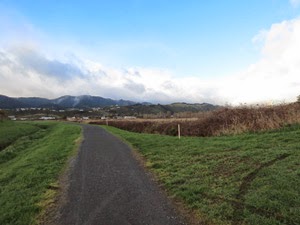Welcome to the Midnight Collective Broadsheet 29
Actively supporting NZ’s endangered wetland birds
One of the rare pleasures
of this investigative work is to stumble across the unexpected and we have had
two such encounters in the past three days. Here is the first, a riroriro, or
grey warbler seen on the track going down to the dune lake.
 |
| Spot the riroriro - white undercarriage centre-right |
This is the NZ rainbird,
whose song reportedly falls away in tone, ending abruptly, if the weather is
about to take a turn for the worst. I remember trekking through Whanganui
National Park territory as a greenhorn and querying the sagacity of this
with a leathery old conservationist of around 75 years. She looked me up and down as yet one more no-hoper
who shouldn’t be allowed near a national park and walked away.
They are little bush
birds, used to living in dense podocarp forest and a nightmare to photograph
because they are difficult to focus and always on the move, fossicking out
insects from the bark and foliage of trees. Rarely seen out in the suburbs like
this, nevertheless here they are -a pair- though we only managed a couple of
messy images of one before they zipped away, across the wharemauku.
 |
| Riroriro (in camouflage) - near dune lake |
The nests of these tiny animals, that vie with rifleman for the title of NZ's smallest bird, (being little
bigger than your thumb), are parasitized by the two native cuckoo’s, -the Shining and Long Tailed. These birds overwinter on South Pacific islands then
migrate back to breed here in the spring. They don’t however, do the legwork themselves, the females laying
their eggs in riroriro nests. We have seen a long tailed fledgling, (koekoea) just out of
the nest on the Island (Kapiti), with two riroriro parents, desperately trying
to keep ahead of its appetite.
 |
| Long-tailed cuckoo - koekoea -ill. Keulemans |
The long tailed, is the
rarest of the NZ cuckoos and it has a loud gnarly cry, which it uses, like its human
counterpart, to galvanise its parents into feeding it. This underlines
the seeming tyranny of the situation for the fledgling, which throws the
riroriro’s own eggs out of the nest, grows to 3 or 4 times the size of the
parents. Though the parents could care less. It is their youngster and there is
no way it is going to be left to starve.
The process raises
intriguing (and intractable) questions about the influence of parenting on a
fledgling. When Don Merton was down on Little Mangere Island. in the Chathams trying to save the black robins
which were down to a last fertile female -Old Blue- (He was famously
successful), the initial strategy was to cuckold the nests of tomtits, with
black robin eggs. This gave Old Blue the opportunity to lay a further clutch. It had to be abandoned
when the robins began to show tomtit-like behaviours. These cuckoos however, repeat
the behaviour of the parents they have never seen, then the females in addition repeat their mother’s parasitic behaviours without however, ever being trained
in the strategy themselves…
And our second surprise? The discovery of marine animals in our small wetland pond over the back of the wharemauku. There seems no obvious way fish can get in here, becasue it has been dry between March and early April, and yet here they are!! It is also decidedly fetid with
cattle having direct access to it. And if this wasn't enough, the expressway has it directly in its sights and is closing in fast from the north. More
on all that next week.
Track we were listening to while posting this
The Big O's Blue Bayou
I'm going back someday come what may to Blue Bayou
Where you sleep all day and the catfish play on Blue Bayou






















